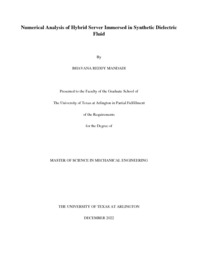
ATTENTION: The works hosted here are being migrated to a new repository that will consolidate resources, improve discoverability, and better show UTA's research impact on the global community. We will update authors as the migration progresses. Please see MavMatrix for more information.
Show simple item record
| dc.contributor.advisor | Dereje, Dr.Agonafer | |
| dc.creator | Mandadi, Bhavana Reddy | |
| dc.date.accessioned | 2023-01-26T16:15:48Z | |
| dc.date.available | 2023-01-26T16:15:48Z | |
| dc.date.created | 2022-12 | |
| dc.date.issued | 2022-12-19 | |
| dc.date.submitted | December 2022 | |
| dc.identifier.uri | http://hdl.handle.net/10106/31049 | |
| dc.description.abstract | In recent years there has been a phenomenal development in cloud computing, networking, virtualization, and storage, which has increased the demand for data centers. With this increase, there is a demand for higher CPU (Central Processing Unit) performance and an increase in the Thermal Design Power (TDP). Maintaining the CPU temperature within the specified parameters for air-cooled servers is a challenge in thermal engineering (due to performance). One of the components of the Data Centers with the largest energy consumption is the cooling system, which uses over 40% of the energy. Advancements in DRAMs and the increased support of CPUs (Central Processing Unit) led to higher power consumption up to 15 W per DRAM and supporting up to 12 DRAMs per CPU. This demands efficient cooling for the overall chassis. In single-phase immersion cooling, electronic components are typically submerged in a thermally conductive dielectric fluid allowing it to conduct heat away from all electrical parts. Therefore, the use of direct contact liquid cooling in data centers with high power dense components has recently been encouraged. In this paper we propose a numerical investigation of effects and improvements when attaching a cold plate to high heat flux components in an immersion cooled environment. Given their extremely low
thermal resistance, cold plates have been demonstrated to have higher heat dissipation rates, and it has been noted that they increase CPU/GPU clock rates (frequency/performance). In this study, the coolant used in the cold plate is PG25 (Dynalene Propylene Glycol) and the fluid used in the tank is a commercially available synthetic dielectric fluid EC-100. The model is built in such a way that only the CPU is cooled using cold plates and the remaining components are cooled by immersion cooling. A baseline CFD (Computational Fluid Dynamics) model using an air-cooled server with heat sinks is compared to the immersion cold server with cold plates attached to the CPU. Results discuss the impact on the temperatures of the components and predict the cooling capabilities of all the components in different test cases which can be used as a trend. | |
| dc.format.mimetype | application/pdf | |
| dc.language.iso | en_US | |
| dc.subject | Immersion cooling | |
| dc.subject | Cisco server | |
| dc.subject | CFD | |
| dc.title | Numerical analysis of hybrid server immersed in synthetic dielectric fluid | |
| dc.type | Thesis | |
| dc.contributor.committeeMember | Miguel A, Dr. Amaya | |
| dc.date.updated | 2023-01-26T16:15:48Z | |
| thesis.degree.department | Mechanical and Aerospace Engineering | |
| thesis.degree.grantor | The University of Texas at Arlington | |
| thesis.degree.level | Masters | |
| thesis.degree.name | Master of Engineering in Mechanical Engineering | |
| dc.type.material | text | |
Files in this item
- Name:
- MANDADI-THESIS-2022.pdf
- Size:
- 2.142Mb
- Format:
- PDF
This item appears in the following Collection(s)
Show simple item record


